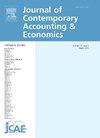Creditor rights and innovation: evidence from a quasi-natural experiment
IF 2.9
3区 管理学
Q2 BUSINESS, FINANCE
引用次数: 0
Abstract
In 2016, the Government of India (GoI) implemented the Insolvency and Bankruptcy Code (IBC), a reform aimed at enhancing creditor rights by enabling creditors to swiftly ‘seize’ and ‘liquidate’ a defaulter’s assets within a defined timeframe. This reform was designed to strengthen creditor protections in India. Our study examines the impact of this reform on firm-level innovation. We hypothesize that creditor-friendly reforms improve access to debt capital, thereby encouraging firms to intensify their innovation activities. Utilizing an entropy-balanced difference-in-differences (Entropy-DiD) approach and leveraging pre-reform variation in firms’ ‘proportion of debt’ for identification, we find that firms with a lower pre-reform ‘proportion of debt’ increased their R&D investment by 29.4 % more than firms with a higher pre-reform ‘proportion of debt’ in the post-IBC period. Supporting our baseline result, we further document that this effect is stronger among more profitable firms within the ‘treated’ group. Our findings are robust to firm-level time-varying control variables, fixed effects for firm and industry by year, and a placebo test using a fictitious IBC promulgation year. These results indicate that stronger creditor rights foster an environment conducive to risk-taking, encouraging firms to pursue ventures that, while risky, hold significant potential for profitability. Consequently, our research highlights the welfare implications of creditor-friendly bankruptcy reforms, providing insights that could inform future policy decisions.
债权与创新:来自准自然实验的证据
2016年,印度政府实施了《破产和破产法》(IBC),这项改革旨在通过使债权人能够在规定的时间内迅速“扣押”和“清算”违约方的资产,从而增强债权人的权利。这项改革旨在加强对印度债权人的保护。我们的研究考察了这一改革对企业层面创新的影响。我们假设债权人友好型改革改善了获得债务资本的途径,从而鼓励企业加强创新活动。利用熵平衡差分法(entroppy - did)并利用改革前企业“债务比例”的变化进行识别,我们发现改革前“债务比例”较低的企业在后ibc时期比改革前“债务比例”较高的企业增加了29.4%的研发投资。支持我们的基线结果,我们进一步证明,在“治疗”组中,这种效应在更有利可图的公司中更强。我们的研究结果对公司层面的时变控制变量、公司和行业按年的固定效应以及使用虚构的IBC颁布年份的安慰剂测试具有鲁棒性。这些结果表明,更强大的债权人权利营造了一种有利于冒险的环境,鼓励企业从事虽然有风险但具有巨大盈利潜力的企业。因此,我们的研究强调了债权人友好型破产改革对福利的影响,为未来的政策决策提供了参考。
本文章由计算机程序翻译,如有差异,请以英文原文为准。
求助全文
约1分钟内获得全文
求助全文

 求助内容:
求助内容: 应助结果提醒方式:
应助结果提醒方式:


